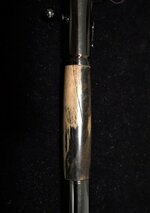vtgaryw
Member
So I stop at this gallery today where I've had some consignment pens for awhile now. I picked up the rest of the first batch I had left there and replaced it with a nice display stand and pens in nice felt boxes. Anyways, I noticed the Bolt Action pen I had there made from lignum vitae had cracked! I was mortified, so very glad I stopped by. I did not stabilize this (I stabilize almost everything) but I've always thought that dense or oily woods should not or cannot be stabilized. This was real lignum vitae bought from a reliable source. It was made probably close to 2 years ago, no idea how long it took to crack. I haven't turned a lot of this wood, but I have a few pieces left and I've been saving it for something special. Any ideas how to treat it?

